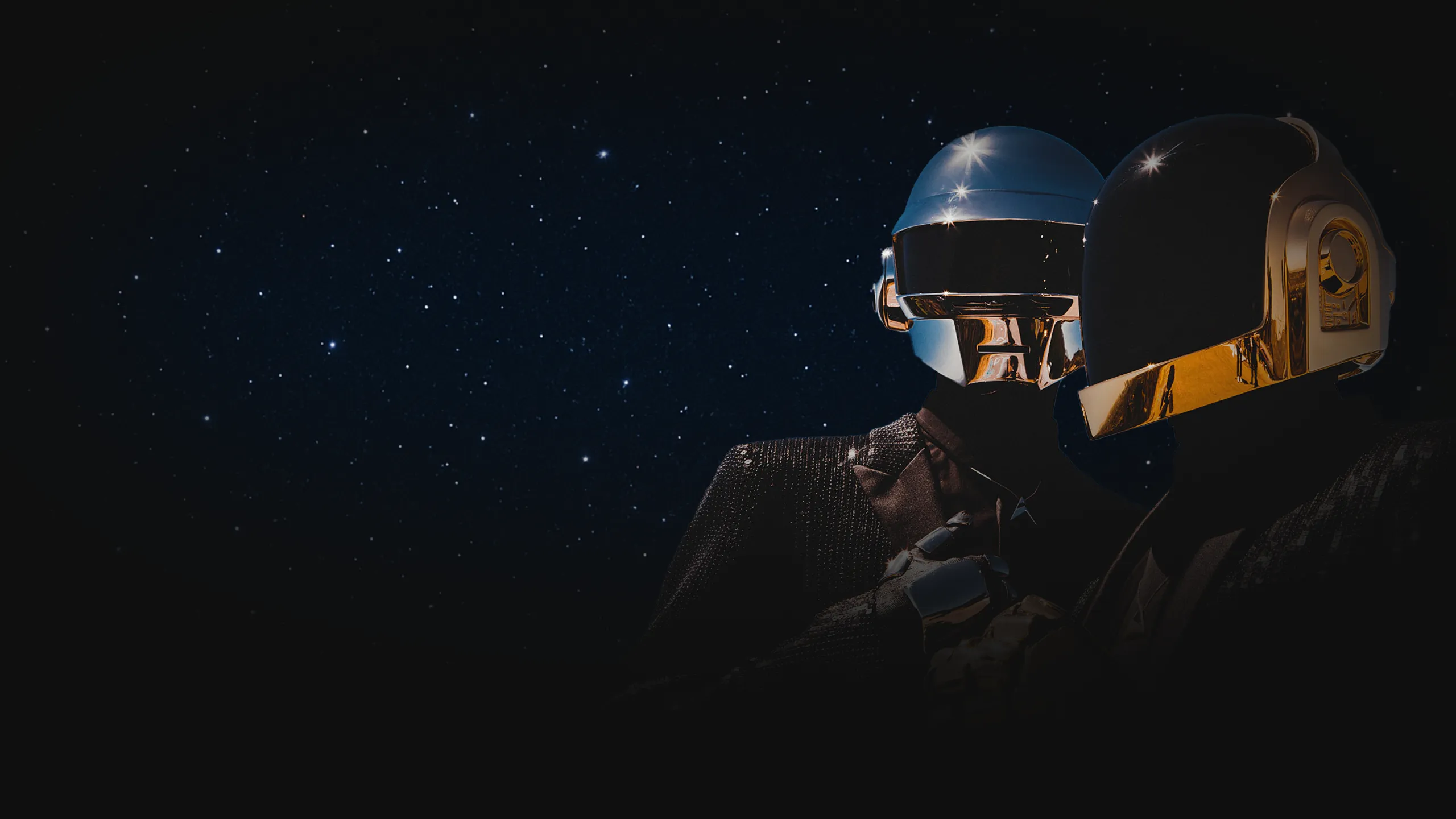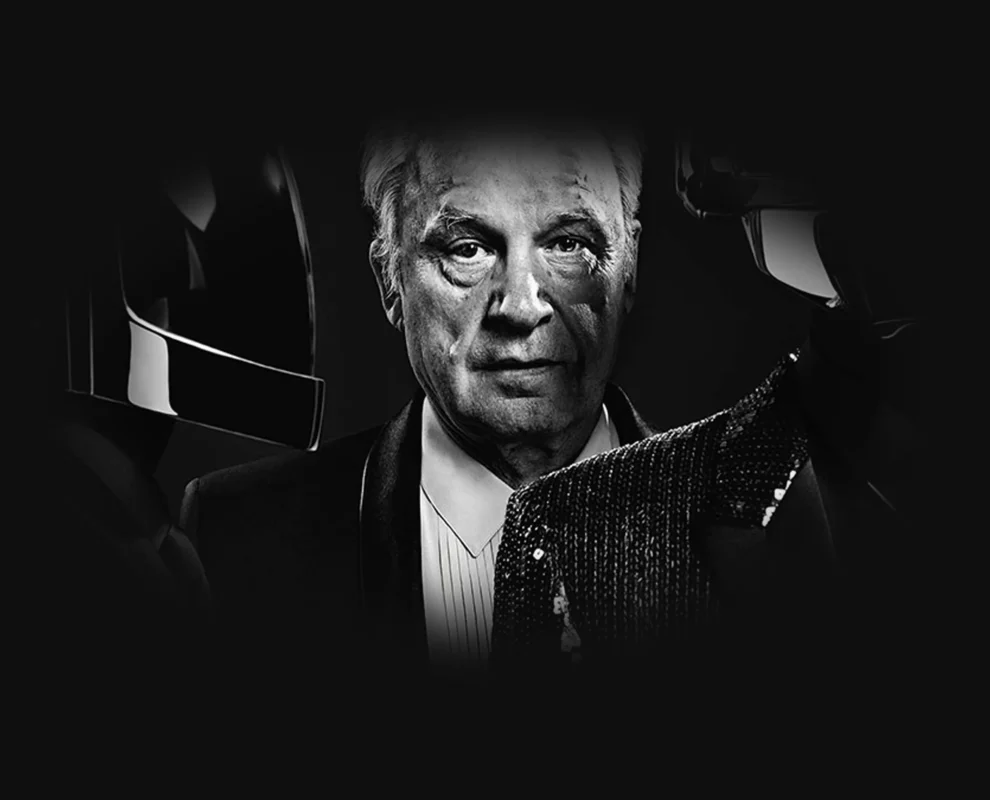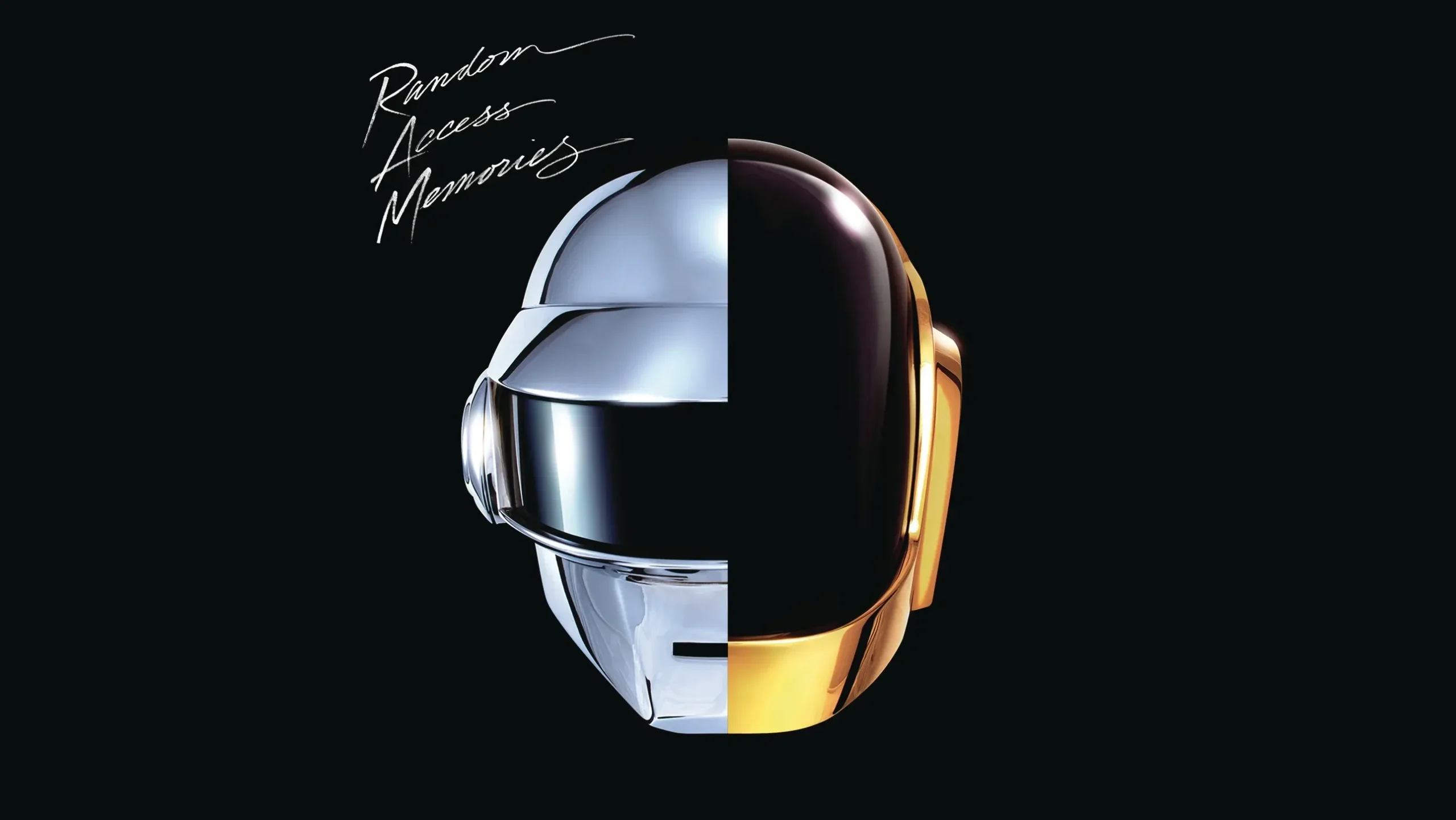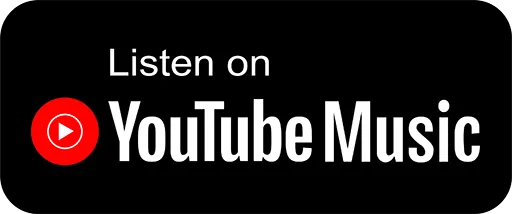Daft Punk’s Random Access Memories: An Album That Defined a Decade
Legends wired into the night sky.

Legends wired into the night sky.
Inside chroma, we follow sound as it shapes culture. Here, we try to focus on evergreen subjects – art that will never age. Few records shaped the 2010s like Daft Punk’s Random Access Memories – a retro-future experiment that became a definitive, global milestone, still widely talked about today, no matter what genre people are into. Analog warmth, disco lineage, and forward vision all collide here. Let’s put the helmet on and step inside.
Listen to Random Access Memories:
1.1) 2013 and the World of EDM
Festival EDM was at its peak in 2013. Big-bass drops, 128-BPM templates, and tracks built to deliver the chorus right away, dominated charts and festival stages. DJs were the headline act and the DAW Macbook Pro was the band; SoundCloud and early streaming playlists fed an always-on release cycle.
Anthems like Avicii’s “Wake me Up“, Skrillex’s “Bangarang“, Swedish House Mafia’s “Don’t You Worry Child” and LMFAO’s “Party Rock Anthem” lead the crowd, and while really cool (I’m still litstening to all of these regularly), the pattern started to form.
Videos: Skrillex’ official MV for “Bangarang” – One of the defining tracks of 2011, and “Don’t You Worry Child” by Swedish House Mafia.
1.2) Back to four-on-the-floor
Into that bassy EDM landscape, Daft Punk moved in the opposite direction. After an eight-year hiatus in record-crafting, if we’re not counting the live stuff and the Tron: Legacy OST, they returned – and instead of louder, faster, and brighter – they went slower, warmer, and analog. They brought in studio players, live takes, tape hiss, disco beats and room tone, and for once, the number of samples found in songs radically decreased. When the moment prized super-saws and endless risers, they bet on groove, space, and feels.
Video: The first teaser of the album, aired on Saturday Night Live on 03.03.2013.
When I saw this initially, my 18-year old brain blew up across the room, with my hands struggling between replaying this snippet and gathering the bits to regain my original form. By the time Get Lucky teased its riff, the message was clear: the future of pop didn’t have to chase the drop any longer. Random Access Memories wasn’t anti-EDM. Instead, it reframed the conversation around instruments, performance and memory. I remember having this exact snippet as my ringtone on my iPhone 3GS since the teaser aired and kept it until I changed the phone, obsessively looking up sketchy websites for a leak of the full album.
2.1) The DNA of Random Access Memories
1970s disco and funk: silky smooth bass, rhythm guitars. If we look to the west, think of Nile Rodgers‘ groovy-happy loop as the main architecture. Think about a 70’s sunny day in Venice Beach, LA, then a late-evening disco party downtown.
Images: …To set the mood. Image 1 source🔗, Image 2 source🔗.
The robots also rolled the globe Europe-bound, all the way to Giorgio Moroder – a disco-legend that made timeless hits such as “Donna Summer – I Feel Love“. Read more about the collaborators in the dedicated section below.
2.2) Studio Craft
RAM privileges technical room tone, allows mic bleed, and decision-making at the source: real players, real takes, analog front-end, and dynamics left intact. Tape and consoles set the stage, while edits and synths serve the performance (instead of replacing it).
Across it all is authorship: honoring the lineage (disco/funk/Euro-disco) while treating the studio as an instrument. Past and future aren’t opposites here; they’re collaborators. The robots took an obsession over the raw sound offered by different well-known studios, recording certain pieces in certain studios, like a ritualistic quest into forging a supernatural record.
Daft Punk recorded Random Access Memories in multiple studios, including Henson Recording Studios, Conway Recording Studios, and Capitol Studios in California, Electric Lady Studios in New York, and Gang Recording Studio in Paris. Each of these studios has at least one legendary, timeless track produced across time. Recording sessions took place over several years in these diverse locations with various musicians and engineers involved in the album’s creation.
I won’t make yet another history lesson about Daft Punk (you can find countless online – I recommend this one🔗). Instead we’ll just study a bit the sound and scene of each album.
3.1) Homework – The Sound of Tomorrow, The Music of Today – 1997
Drum machines, samplers, loop discipline. Fuzzy kicks, filters, and repetitive hooks built for basements and rave parties. “Da Funk” acid bass and “Around the World” (lyrics are “Around the World” times 144 – which is 12 squared… yeah) show the formula: simple motifs, groove over gloss. The point wasn’t pristine sound – it was a daft punk movement. Homework received critical acclaim and significant recognition for its groundbreaking influence on French house music and global dance culture.
Video: Official MV for “Around the World” – One of the defining tracks of the Homework album.
They weren’t robots yet, but two French blokes who treasured music over image. Before the chrome helmets, Thomas Bangalter and Guy-Manuel de Homem-Christo showed up in the flesh, or behind masks that shifted with the occasion – cloth bags, Halloween knock-offs, whatever blurred identity enough to keep the focus on sound. In spirit, not far from what Empire of the Sun would do later: disguise as a statement, not a gimmick.
Gallery: Thomas Bangalter and Guy-Manuel de Homem-Christo in the Homework era.
3.2) Discovery – The sampling era, elevated (2001)
This is French touch turned cinematic: lush sample choices from late-70s/early-80s disco/funk and slick micro-chops that feel like new songwriting – if you listen to the original songs, then the samples – you’ll consider it unreal. “Digital Love” (George Duke’s “I Love You More”) and “Harder, Better, Faster, Stronger” (Edwin Birdsong’s “Cola Bottle Baby”) are masterclasses in re-contextualization; “Superheroes” loops a buried Barry Manilow phrase into an early but modern electronic build-up.
As a showcase, I picked “Face to Face“, featuring Todd Edwards – a work of art which splices over 25 distinct songs, totalling at approximately 70 micro-samples. 24 years later, there still are some that haven’t been discovered yet. It’s a wild ride, and I love it so much. In the comparison below, you’ll have the official MV of “Face to Face” (from the Interstella 5555 musical anime movie, a Japanese-French collab – worth watching), and an artist’s closest recreation to date, done with modern tools. Imagine doing this in 2001.
I plan on doing an in-depth analysis of this in the future.
Videos: official MV for “Face to Face” and an artist’s recreation.
Parallel to the album, the side projects codified the scene’s DNA:
– Stardust – “Music Sounds Better With You” (Thomas + Alan Braxe + DJ Falcon): a Chaka Khan “Fate” slice turned into a world anthem, still blasted and remixed at almost every party today. Keeping the anonimity, the 3 french DJs set off one of the definitive house songs of all time.
Video: official MV for “Music Sounds Better with You“.
More important French Touch tracks worth mentioning:
– Le Knight Club (Guy-Manuel + Eric Chédeville / Crydamoure): glossy french-house, sleek hi-hats, elegant compression, sampling Sister Sledge, Cerrone and other important records of the disco times.
– Roulé / Crydamoure labels: DJ-first 12″s.
– Together (Thomas + DJ Falcon): “Together,” “So Much Love to Give” (The Real Thing resampled) – maximal emotion.
This is when Thomas and Guy-Man solidified the robot look and wore their helmets everywhere. Photos of the two guys availability radically dropped to almost 0%. The robots took over.
Gallery: Thomas Bangalter and Guy-Manuel de Homem-Christo in the Discovery era.
Discovery is a must-listen, being nominated numerous times and placed at number 3 on The 200 Best Albums of the 2000s🔗 by Pitchfork and number 8 of 30 Greatest EDM Albums of All Time🔗 by the Rolling Stone.
3.3) Human After All – More abrasion (2005)
A test of how far repetition and texture can carry momentum. It reads colder on record, but its stems were built to be recombined. Remember legendary tracks such as “Human After All” which samples Breakwater’s “Release the Beast”. The vocoders are given much more care this time around, being fine-tuned to the exact signature sound we know and love, describing the general feel of the album: emotional and human.
The robots wore leather jackets now. Their chrome visors reflected harsher light, stripped of disco shimmer and Discovery’s neon hues. Gone were the tailored suits and superhero poses – replaced by raw textures, studded belts, and a stripped-down aesthetic. They looked less like untouchable icons and more like underground rebels, leaning into the gritty, mechanical edge that defined Human After All. These suits are used during the legendary Alive 2007 tour and the Electroma movie.
Gallery: Thomas Bangalter and Guy-Manuel de Homem-Christo in the Human After All and Alive 2007 era.
3.4) Random Access Memories
Instead of mining memory via samples, they perform memory with collaborators and arrangements. This is the last album we’ll ever see from the robots. To this day, I still hope otherwise.
The robots traded leather grit for pure elegance. Their look evolved into sleek Saint Laurent tuxedos, paired with crystal-studded helmets and gloves. The sharp tailoring contrasted against the disco shimmer of Discovery and the industrial minimalism of Human After All. Instead of underground rebellion, the duo now resembled cosmic gentlemen – timeless figures walking the red carpet of another dimension.
The vocoders are now mastered to perfection. Unmistakable, definitive, cool, plugged-in, digital but analog.
Gallery: Thomas Bangalter and Guy-Manuel de Homem-Christo in the Random Access Memories era (2013).
Random Access Memories is a curated house band. Daft Punk cast people as instruments – each voice, touch, or story chosen to serve the thesis: performance as the new sample. I remember the “Collaborators” playlist, which can be seen on Youtube🔗. They took almost all of the collaborators up for an interview. Instead of learning for my finals, I was desperately searching for when the next Collaborators video releases.
With Random Access Memories, Thomas and Guy-Man mature, become timeless, legendary, definitive. The collaborators, listed below:
– Nile Rodgers – razor-clean happy guitar comping, architecture. Hear the riffs in “Get Lucky,” “Lose Yourself to Dance,” “Give Life Back to Music.”
– Pharrell Williams – featherweight words of goodwill; he sells the groove without oversinging. Featured in “Get Lucky,” “Lose Yourself to Dance.”
– Giorgio Moroder – the origin myth in his own voice; from click track to cosmos. “Giorgio by Moroder” is the album’s manifesto.
– Paul Williams – Broadway heart; the record’s moral center. “Touch” turns memory into theatre.
– Todd Edwards – micro-chop romantic from the Discovery era, one of the geniuses behind “Face to Face”; here, he writes it instead of slicing it. “Fragments of Time.”
– Julian Casablancas – frontman of The Strokes, vocodered stoicism. “Instant Crush.”
– Panda Bear – mantra clarity; one line, endless lift. “Doin’ It Right.”
– Chilly Gonzales – piano math prelude and restraint; space as statement. “Within.”
– DJ Falcon – Sampling mastery in “Contact.”
– Omar Hakim / JR Robinson – living drum feel. Clean, raw.
– Nathan East / James Genus – juicy bass lines.
To me, none of this reads as nostalgia. It’s lineage made present, and the robots conduct and lead the album to the stars. All their previous work was a build up to this mastercraft.
Gallery: The collaborators of Random Access Memories.
Video: One of the collaborator of Random Access Memories from the Youtube video series.

“Once you free your mind about a concept of Harmony and of music being “correct”,
You can do whatever you want.”
– Giorgio Moroder in “Giorgio by Moroder”
The album opens with “Give Life Back to Music” – a sentence that doubles as a mission:
“Let the music in tonight / Just turn on the music / Let the music of your life / Give life back to music.” repeated eight times, like a toast – or a ritual?
No clever twist, no dense poetry, just a clear invite: let music lead for a moment, forget your troubles and let it wake you up. The vocoders are on point, crafted and detailed to perfection, letting you to hear all the electronic imperfections produced by the Digitech Talker🔗 (not official but I’m pretty sure they used that one). This contrast always amazed me: A robotic voice spelling clean, simple words of human wisdom. Beautiful.
I heard it the way it was meant to be heard once: a warm night in Vama Veche, 2014. Large beach crowd, salty air, a single strobelight cutting into the dark. The chorus hit, strangers started moving in sync, and I felt great – simple as that. I went straight for a gin tonic – also exactly how I think it was meant to be enjoyed – and let the track carry the night. No debate, no analysis; just yes.
Images: Poster of Give Life Back to Music and a warm night in Vama Veche.
A song built for togetherness. Riff, clap, falsetto – instant recognition in three seconds. No big drop, no tricks, just a steady groove that invites you in and keeps you there. In its prime, it was everywhere: parties, clubs, weddings, taxis, radio – played because it worked for everyone, every time.
Another one that reads like a communal toast, with mystical notes: “We’ve come too far to give up who we are / So let’s raise the bar and our cups to the stars.” It’s simple optimism – self-belief, celebration, and a little cosmic wink. And the mantra “We’re up all night to get lucky” is both a flirt and a promise: stay present, keep moving, good things might happen.
As part of the album’s mission, “Get Lucky” is proof-of-concept. Live players, on-point vocoder moment complemented by a kickass bass – sustains presence and joy. In my opinion, it’s the warmth that made it spread, winning the 56th Annual Grammy for Best Pop Duo/Group Performance, where it was also performed live, featuring Stevie Wonder, Pharrell Williams, Nile Rodgers. Seeing Sir Paul McCartney dance to it in the video below is a sight to behold. Pair this with “Lose Yourself to Dance” and you’ve got yourself a Grammy Award.
Video: Get Lucky performed live at the 56th Annual Grammy Awards.
A short documentary set to a groove, a “Bohemian Rhapsody” of disco. Giorgio Moroder talks about his path – youth, clubs, discovery – and Daft Punk build a 9-minute world under his voice. The french robots’ idea is simple and bold: let the pioneer tell his own origin, then score it in real time. The bass is rich, leading the rhythm, with funky guitars in the background, until they are shadowed by the “sounds of the future”. I won’t spoil the rest. It is unique, special, amazing.
It starts small and bare – just time ticking – and grows section by section: steady pulse, bassline, keys, strings, (and an amazing electric guitar), everything rising around his words. By the end, it feels like a movie about invention, where memory turns into momentum.
Considered one of the best tracks of the record by many fans, here is why it matters: the track is the album’s thesis. Daft Punk weren’t celebrating the synths for their own sake, like “look at this synthesizer, isn’t it futuristic.” They were showing that technology only matters when it serves a human story. You hear such a life story and a music lesson at once – be brave, be specific, and build the future with your hands, as there are no rules or preconceptions for “correct“. You can do whatever you want. This goes farther than music, in my opinion, it’s about one’s life and purpose, and to keep the future human.
Video: Giorgio Moroder’s experience of meeting Daft Punk.
4.1) Fragments of Time – Writing memory instead of sampling it
Todd Edwards (the micro-chop architect from Discovery’s “Face to Face” masterpiece) returns not to slice, but to co-write and sing. The lyric is road-light nostalgia – “turning our days into melodies” – and that’s the point: RAM trades momentary bliss for definitive memory. It’s two friends capturing a feeling while it’s still warm, then pressing it to wax.
4.2) Touch – The album’s heart
A wonderful and touching story told by Paul Williams, a suite actually – that drifts from stage-musical into a synth dream and lands on a choral conclusion where the robots chant with a women’s chorus – “Hold on, if love is the answer, you’re home.” It’s shelter, can be religion. It’s RAM in one scene: memory -> wonder -> love -> home – similar to what I’m doing on Unbound Planet… maybe these songs influenced me more than I previously thought.
4.3) The Game of Love – Vocoder as confession
No drama, no big lift; just the quiet orbit of loss. Human, after all.
4.4) Beyond -> Motherboard – Transcendence into creation.
“Beyond” opens with strings and a gentle manifesto – “Remember love’s our only mission.” It points to: cosmic, timeless, a promise. “Motherboard” answers by pointing in: acoustic guitar, flowing percussion, watery textures, heartbeat bass, life assembling itself in sound. Back-to-back, they read like philosophy in two pages: spirit -> biology, sky -> lake. The perfect song is framed with silence; It speaks of places never seen.
Photo: Daft Punk as celestial legends, appearing in their feature with The Weeknd’s megahit “I Feel It Coming🔗“.
“Contact” is RAM’s final flare: NASA radio chatter (from Apollo 17, Eugene Cernan) rides a looping sample of The Sherbs’ “We Ride Tonight” – the album’s only true sample – then the track stacks until it feels like liftoff. Longtime ally DJ Falcon co-pilots; the Sherbs motif even surfaced in a 2002 Together set before returning here as a grand goodbye. It’s a perfect close: memory, machinery, and momentum burning white-hot.
Step back: Random Access Memories swept the 2014 Grammys – Album of the Year, Best Dance/Electronica Album, Best Engineered (Non-Classical); “Get Lucky” took Record of the Year and Best Pop Duo/Group Performance. A decade on, the 10th-anniversary reissue kept the conversation going. The French duo re-centered pop around feel, players, and songcraft.
On February 22, 2021, Daft Punk signed off with the eight-minute “Epilogue” – quiet, cinematic, final. The message landed; the influence didn’t fade. We still want need more, and now more than ever.
As of 2025:
– Thomas Bangalter – moved into composition and stage works: the orchestral Mythologies (2023), the Daaaaaalí! film score (2024), and the Chiroptera performance soundtrack (2024). In interviews he framed the split as leaving the “robot” behind; in 2025 he also composed for Anrealage’s Fall show in Paris.
– Guy-Manuel de Homem-Christo – largely low-profile, but returned in 2023 as a producer on Travis Scott’s “Modern Jam.“
From Homework’s warehouse loops to Discovery’s mastercrafted sample-made pop and finally to Random Access Memories’ room analog-tone glow, Daft Punk kept asking the same question: “How do you make machines feel?”. This is the contrast, the helmets were two humans stepping back so groove, melody and community (see Alive 2007) could step forward. Their blueprint reshaped clubs, pop radio, stage design, and even after the 2021 farewell, the signal keeps traveling. The robots are gone, for now, but the feeling isn’t.
“Hold On, if love is the answer, You’re home.”
Let the music in tonight, give life back to music – and the music will give life back to us.
This is one of my all-time favorite albums. I replay it as often as I can, together with their other mastercrafts. Thanks for reading.

I opened this one calling RAM an album that defined a decade. After relistening, digging into its grooves, and tracing its echoes, it’s more than that: a once-in-a-generation experiment that dared to slow down the digital rush and remind us of music’s analog soul. It’s the robots growing up together with us – a buildup of all their great records.
‘Random Access Memories’ shaped me in quieter ways – the way great art should. From Giorgio’s manifesto to the flashy lift of Get Lucky, it reminded me that pop could still feel alive, tactile, and cinematic. When I hear it today, I don’t just hear ‘Highschool, 2013’ – I hear a mirror ball spinning across decades, from disco floors to future stages not yet built. Timeless.
The album closes with ‘Contact’, a NASA sample burning into distortion – a reminder that endings are also transmissions, as we like to do it across these parts. That’s what RAM (and Daft Punk as a whole) remains: an evergreen broadcast from two masked French architects, fusing memory and machine, past and possible. As previously stated, decades later, their music hasn’t aged: it’s suspended, timeless.
If you’re new: play RAM whole, in order, on good headphones or a big soundsystem, no skips. Let the imperfections breathe, let the collabs surprise you, and let the silence between notes remind you what music can be. This one isn’t just a great record… it’s great art, and that’s what chroma is all about. Thanks for tuning in – you’re awesome.
Much more sound, art, and experiment is coming soon, so:
Stay tuned right here, on Unbound Planet, with your favorite host.
–Theo
Contact me🔗 for suggestions, feedback, ideas.
sources: hero


